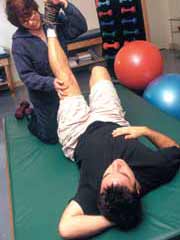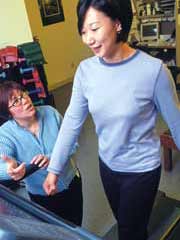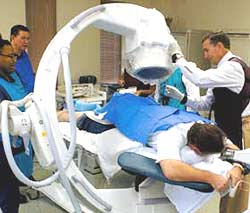Preventing chronic back pain should begin within six to 12 weeks following an injury
Shepherd Center takes team approach to pain management.
|
ATLANTA — With one eye on two radiographic images displayed on separate screens at the head of the patient table, Randy Rizor, MD, inserts a 25-gauge needle into the lower spine of his elderly female patient.
Two more C-arm radiograph pictures — one lateral, the other posterior — as well as the patient’s pained reaction, confirm that Rizor has found the L5 nerve root he has been seeking.
The patient’s pain subsides quickly after Rizor administers a local anesthetic through the needle and onto the nerve root, and her chronic hurt will remain at bay for at least several months due to the high-potency steroid injected next.
“It’s not a cure, but it is the least invasive method,” Rizor said, following the 15-minute procedure.
“You could make a case for surgery, but the overall outcome probably wouldn’t be much better,” added Rizor, who is medical director of the Center for Spine Care at the Shepherd Center in Atlanta.
An average of 30 such procedures are performed daily throughout the year at Shepherd’s spine center by Rizor and two other physicians, but stopping pain at the source is just one part of a team approach that works hard to educate and rehabilitate patients, as well as erase the stigma of their being treated at a pain management facility.
Down the hallway from the procedure room is where the rest of the Shepherd team does its work, which includes counseling, education and physical therapy.

A multidisciplinary approach
“A team approach to treating chronic pain is better,” said David Apple, MD. Apple is medical director of the Shepherd Center, which he also helped establish. Apple was the recipient of the American Academy of Orthopaedic Surgeons Humanitarian Award in 2002 for his role in starting the center for patients with spinal cord injuries in 1975.
|
The Shepherd Center started as a six-bed unit attached to a hospital and is now a full-service rehabilitation facility that annually treats more than 850 patients with spinal cord and brain injuries, multiple sclerosis, and neuromuscular and urological conditions.
In a recent interview at the center, Apple said that more people with good credentials are needed to specialize in pain management.
The team at Center for Spine Care at Shepherd includes Rizor and fellow board-certified pain practitioner Darrell N. Simone, MD; Brock D. Bowman, MD, who is certified in physical medicine and rehabilitation; physical therapist Karen Feder; and rehabilitation counselor Marilyn T. Oakes.
While each player on the multidisciplinary team plays their traditional parts, having physicians, a therapist and a counselor in one place is the innovation that has been effective in addressing spinal pain before it has time to become chronic.
“We are achieving the goal of seeing patients earlier rather than being the court of last resort,” Apple said.
The trouble with preventing chronic back pain is the limited time frame — six to 12 weeks following a back injury — in which treatment can be effective.
Since about 80% of back injuries heal without chronic pain, the remaining 20% of patients are often prescribed medication and not seen by a pain specialist until well after three months post-injury, Rizor said. “The clock starts ticking at the time of injury,” he said.
Typically, a patient with a back injury will first see a primary care doctor, who will treat them for a few weeks before sending them to an orthopedist, Rizor said. Only a very small number, about 3%, require surgery, so the rest are directed to physical therapy or back to a general practitioner for a pain medication prescription.
“That’s where you get trapped for another four to six weeks and lose your critical window for treatment,” Rizor said.

Pinpointing pain for treatment
|
While the first step in the multidisciplinary approach — locating the origin of pain — may seem logical, it is not always explored thoroughly. “Most back pain is identified as nonspecific, but we specifically identify the underlying pain generator,” Rizor said.
That’s done through a “precision diagnosis” that can reveal any one or a combination of four places that pain can originate: paraspinal muscles, joint structures, intervertebral discs and compressed nerves.
Radiographic images can help narrow down possible pain generators, but pictures might only show abnormalities, not the pain itself. The diagnosis must be confirmed with a selective spinal injection of a local anesthetic, such as bupivacaine, on the presumed pain generator. If the pain goes away, the diagnosis was correct and treatment can begin.
“If we identify the specific pain generator, we can use nerve blocks to reduce pain and give a window for physical therapy,” Rizor said.
Starting physical therapy immediately after a precision diagnosis is crucial to preventing chronic pain, Rizor said. “Unless there’s a close working relationship between pain intervention and physical therapy, the patient will not have sufficient therapy for progress.”

Diagnosis to therapy
|
While making a quick transition from diagnosis to physical therapy is critical for any patient hoping to avoid or work through chronic pain, it can play an equally important role in bolstering a patient’s attitude, which is vital to a treatment program, Apple said.
“It’s important to get them early before they have a chance for the pain mindset to take hold.”
Apple said having a counselor and therapist on hand, in addition to physicians, is especially valuable in helping prevent the mindset of pain. “This is a more condensed approach.”
Part of preventing a pain mindset is helping patients understand their pain and what it means, according to Karen Feder, physical therapist for the spine center. “In working through pain, patients need to know that they’re not just hurting themselves more,” she said. Specifically, patients must understand the difference between hurt and harm, Feder said. The adage of “no pain, no gain” applies to physical therapy.
|
A patient with pain from an injury may be inclined to curtail movement, which leads to a loss of muscles and more pain. Some pain is necessary to stretch and strengthen muscles. Such pain will ultimately help reduce pain levels and lead to return to work, sports or other life activities.
“If you don’t move your back, you don’t experience pain, which is why therapy can make people feel like they’re getting worse instead of better,” she said. “That’s also why it’s best to get patients soon after their procedures, when pain levels are low.”
Developing a positive attitude about rehabilitation is important, according to Shepherd’s rehabilitation counselor, Marilyn Oakes. Oakes provides patient assessment, education, medication management classes, individual and group counseling and behavioral services. She also coordinates the “Back in Action” rehabilitation program at Shepherd. Oakes is one of only 24 certified rehabilitation counselors in the United States with a dual certification in pain management.
Oakes also has the ability to make a special connection with chronic pain patients, as she developed a chronic pain of her own in the form of daily migraine headaches.
“Technically, all pain is in your brain,” Oakes said. She noted that when patients enter a counseling program, there is a misconception that they are there because doctors believe they have a mental problem. But persistent pain can lead to structural changes in the brain, essentially opening the “pain gate,” leading to a chronic state that is difficult to overcome, she said.
Oakes leads several programs, including a 12-hour class on pain education. The class educates patients about strategies to deal with pain, including medication management, relaxation techniques, diet and other lifestyle choices, and helps them understand what makes the pain better or worse.
That class can be followed by a second, more advanced 12-hour pain education class. Some patients then elect to continue with individual therapy. “The goal is to promote self-care,” she said.

Back to work
While the spine center’s physicians, therapist and counselor work together, their roles are also linked in the Back in Action program. The six-week program varies somewhat to cater to each patient’s goals but always includes three phases: treatment, conditioning and skill building, and transition to work/follow-up.
|
||
In the treatment program, goals and expectations are established for both the patient and the treatment team, with a prescribed course of therapy and psychological interventions. Medication and adherence to the program are monitored.
Once the treatment team is convinced that the patient will follow the program, the second and most intense phase begins. Conditioning and skill building includes three weekly visits a month to the clinic for physical therapy and psychological counseling.
The final phase follows the patient to work, monitoring and offering support as needed. Help is available for those who relapse.
Continuity is the key to any good rehabilitation program, said Robert W. Wildmon, an administrator for the spine center. “Sporadic treatment will not help. They need to be managed very closely over a duration of time, even if a relatively short period.”
Many patients may hope to regain as much of their presurgery abilities as possible, but sometimes the goal is more short term. In one case, an airline baggage handler had to briefly return to his same job, which requires him to lift up to 70 lbs, before the airline could transfer the employee to a less strenuous occupation within the company.
Wildmon said having an orthopedist on the local workers’ compensation panel has improved Shepherd’s ability to find patients appropriate for its style of treatment and, therefore, returning more people to work. He said more awareness about pain management facilities will improve the outlook.
“If an orthopedist is not in tune to pain care, they are shortening the window of success for returning people to employment,” Wildmon said.

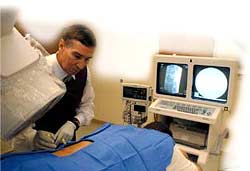
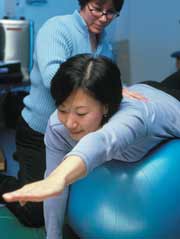
![David Apple, MD [photo]](/~/media/images/news/print/orthopedics-today/2003/11_november/davidapple_70_90_1604.jpg) David Apple, MD was the
recipient of the American Academy of Orthopaedic Surgeons Humanitarian Award in
2002 for his role in starting the center.
David Apple, MD was the
recipient of the American Academy of Orthopaedic Surgeons Humanitarian Award in
2002 for his role in starting the center.